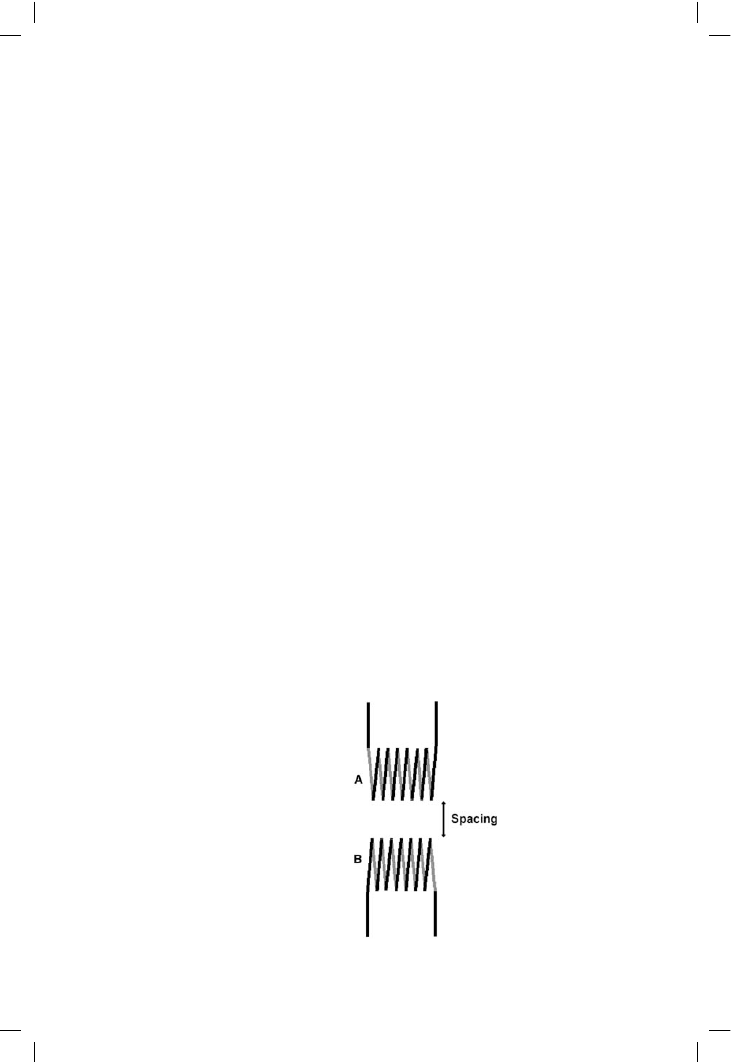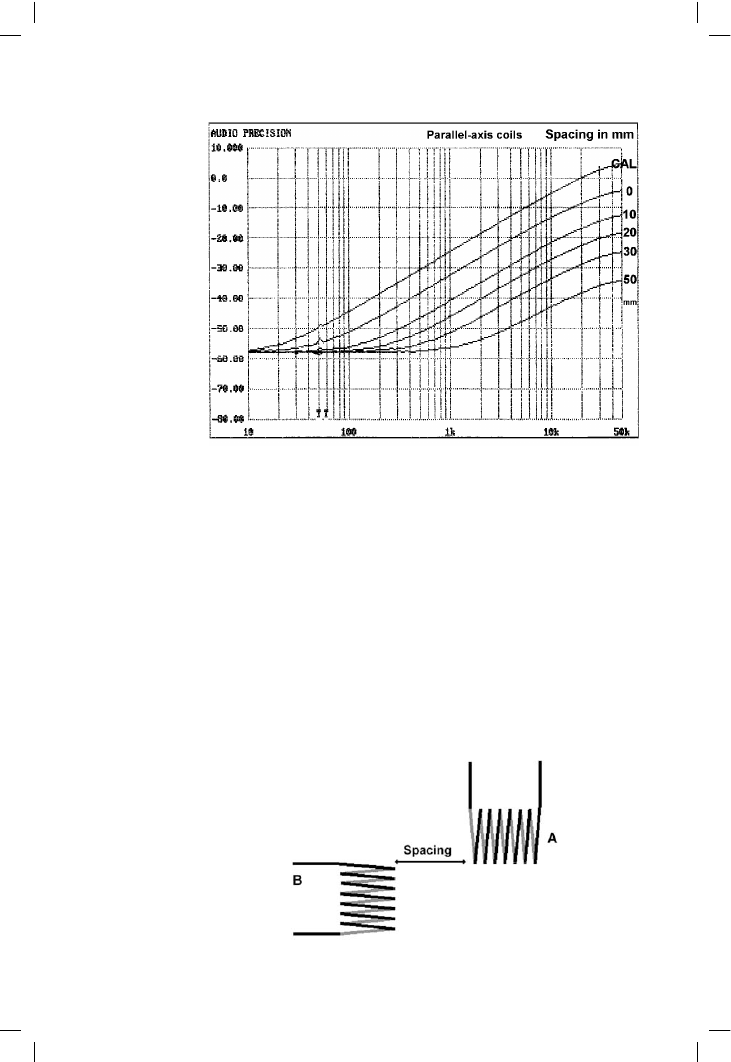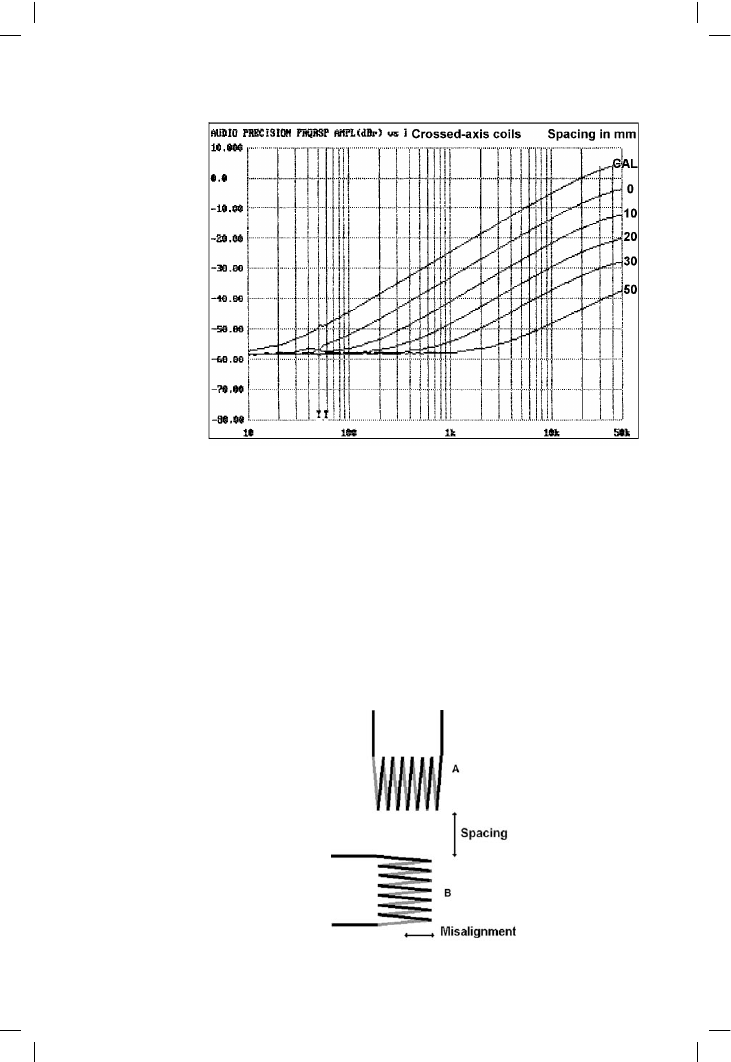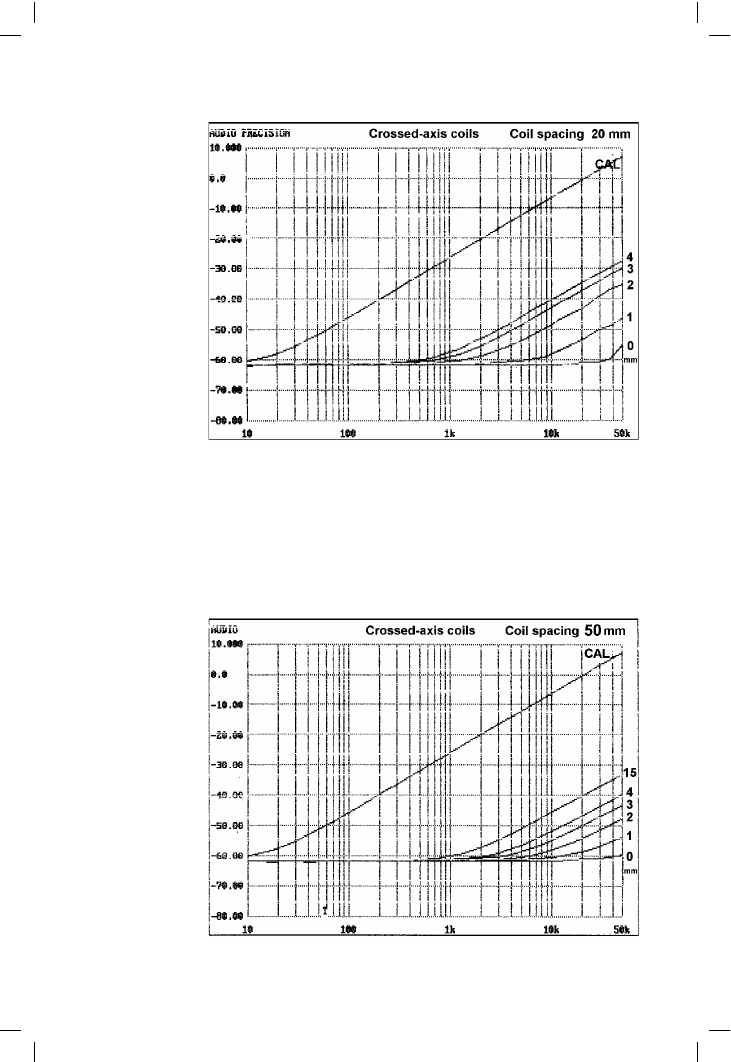ВУЗ: Казахская Национальная Академия Искусств им. Т. Жургенова
Категория: Учебное пособие
Дисциплина: Не указана
Добавлен: 03.02.2019
Просмотров: 17430
Скачиваний: 18

Compensation, slew-rate, and stability
where the frequency response is flat. In a transformer the primary
inductance is much greater than the circuit series impedance, so the
magnetic flux that couples with the secondary halves when the input
frequency doubles, and the voltage induced in the secondary is constant.
The crosstalk at 20 kHz was taken as the 0 dB reference. This represented
2.4 mV rms across Coil B. 100 mA rms in Coil A corresponds to 800 mV rms
across an 8 ! load, so this gives a final crosstalk figure from channel to
channel of –54 dB at 20 kHz. It carries on deteriorating above 20 kHz but
no one can hear it. All crosstalk figures given below are at 20 kHz.
The coils were then separated 10 mm at a time, and with each increment the
crosstalk dropped by 10 dB, as seen in Figure 7.17. At 110 mm spacing,
which is quite practical for most designs, the crosstalk had fallen by 47 dB
from the reference case, giving an overall crosstalk of 54 + 47 = 101 dB total.
This is a very low level, and at the very top of the audio band. At 1 kHz, where
the ear is much more sensitive, the crosstalk will be some 25 dB less, which
brings it down to –126 dB total which I can say with some confidence is not
going to be a problem. This is obtained with what looks like the least
favourable orientation of coils. Coil–coil coupling is –32 dB at 50 mm, and
the figure at this spacing will be used to compare the configurations.
The next configuration tested was that of Figure 7.18, where the coils have
parallel axes but are displaced to the side. The results are in Figure 7.19; the
crosstalk is now –38 dB at 50 mm. With each 10 mm spacing increment the
crosstalk dropped by 7 dB. This setup is worse than the crossed-axis version
but better than the coaxial one.
The final configurations had the axes of the coils at 90 degrees; the crossed-
axis condition. The base position is with the corners of the coils touching;
see Figure 7.20 When the coil is in the position X, still touching, crosstalk
almost vanishes as there is a cancellation null. With the coils so close, this
is a very sharp null and exploiting it in quantity production is quite
205
Figure 7.18
The coil configuration
for non-coaxial
parallel-axis coils

Audio Power Amplifier Design Handbook
impractical. The slightest deformation of either coil ruins the effect. Moving
the Coil A away from B again gives the results in Figure 7.21. The crosstalk
is now –43 dB at 50 mm, only an improvement of 11 dB over the coaxial
case; turning coils around is clearly not as effective as might be supposed.
This time, with each 10 mm spacing increment the crosstalk dropped by
8 dB rather than 10 dB.
The obvious next step is to try combining distance with cancellation as in
Figure 7.22. This can give a good performance even if a large spacing is not
possible. Figure 7.23 shows that careful coil positioning can give crosstalk
better than –60 dB (–114 dB total) across the audio band, although the
spacing is only 20 mm. The other curves show the degradation of
performance when the coil is misaligned by moving it bodily sideways by
1, 2, 3 and 4 mm; just a 2 mm error has worsened crosstalk by 20 dB at
20 kHz. Obviously in practice the coil PCB hole won’t move – but it is very
possible that coils will be bent slightly sideways in production.
206
Figure 7.19
Crosstalk vs spacing
for parallel-axis coils
Figure 7.20
The coil configuration
for crossed-axis
measurements

Compensation, slew-rate, and stability
Figure 7.24 gives the same results for a 50 mm spacing, which can usually
be managed in a stereo design. The null position once more just gives the
noise floor across the band, and a 2 mm misalignment now only worsens
things by about 5 dB. This is definitely the best arrangement if the spacing
is limited.
Conclusions
Coil orientation can help. Simply turning one coil through 90 degrees gives
an improvement of only 11 dB, but if it is aligned to cancel out the
coupling, there is a big improvement. See how –38 dB in Figure 7.19
becomes –61 dB in Figure 7.24 at 20 kHz. On a typical stereo amplifier
207
Figure 7.21
Crosstalk vs spacing
for crossed-axis coils
Figure 7.22
The coil configuration
for crossed-axis with
cancellation

Audio Power Amplifier Design Handbook
PCB, the coils are likely to be parallel – probably just for the sake of
appearance – but their spacing is unlikely to be less than 50 mm unless the
output components have been deliberately grouped together. As with
capacitative crosstalk, physical distance is cheaper than anything else, and
if the results are not good enough, use more of it. In this case the overall
crosstalk at 20 kHz will be 54 + 38 = –92 dB total, which is probably
208
Figure 7.23
Crosstalk vs alignment
for crossed-axis coils
spaced at 20 mm,
using cancellation
Figure 7.24
Crosstalk vs alignment
for crossed-axis coils
spaced at 50 mm,
using cancellation

Compensation, slew-rate, and stability
already well below other forms of interchannel crosstalk. A quick quarter-
turn of the coil improves this to at least –114 dB. It should do.
Reactive loads and speaker simulation
Amplifiers are almost universally designed and tested running into a purely
resistive load, although they actually spend their working lives driving
loudspeakers, which contain both important reactive components and also
electromechanical resonances. At first sight this is a nonsensical situation;
however, testing into resistive loads is neither naive nor an attempt to avoid
the issue of real loads; there is in fact little alternative.
Loudspeakers vary greatly in their design and construction, and this is
reflected in variations in the impedance they present to the amplifier on
test. It would be necessary to specify a standard speaker for the results from
different amplifiers to be comparable. Secondly, loudspeakers have a
notable tendency to turn electricity into sound, and the sinewave testing of
a 200 W amplifier would be a demanding experience for all those in
earshot; soundproof chambers are not easy or cheap to construct. Thirdly,
such a standard test speaker would have to be capable of enormous power-
handling if it were to be able to sustain long-term testing at high power;
loudspeakers are always rated with the peak/average ratio of speech and
music firmly in mind, and the lower signal levels at high frequencies are
also exploited when choosing tweeter power ratings. A final objection is
that loudspeakers are not noted for perfect linearity, especially at the LF
end, and if the amplifier does not have a very low output impedance this
speaker non-linearity may confuse the measurement of distortion. Amplifier
testing would demand a completely different sort of loudspeaker from that
used for actually listening to music; the market for it would be very, very
small, so it would be expensive.
Resistive loads
Amplifiers are normally developed through 8 and 4 ! testing, though
intermediate values such as 5.66 ! (the geometric mean of 8 and 4) are
rarely explored considering how often they occur in real use. This is
probably legitimate in that if an amplifier works well at 8 and 4 ! it is most
unlikely to give trouble at intermediate loadings. In practice few nominal
8 ! speakers have impedance dips that go below 5 !, and design to 4 !
gives a safety margin, if not a large one.
The most common elaboration on a simple resistive load is the addition of
2 µF in parallel with 8 ! to roughly simulate an electrostatic loudspeaker;
this is in fact not a particularly reactive load, for the impedance of a 2 µF
capacitor only becomes equal to the resistance at 9.95 kHz, so most of the
audio band is left undisturbed by phase shift. This load is in fact a worse
approximation to a moving-coil speaker than is a pure resistance.
209